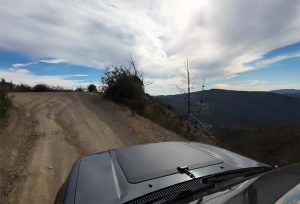Off-roading offers an exciting way to connect with nature, but it comes with the responsibility to act sustainably and courteously. The following ten rules of off-road trail etiquette help maintain the environment and ensure safety and enjoyment for all trail users. By adhering to these guidelines, off-roaders can help preserve the natural areas they explore and ensure that these spaces remain accessible and enjoyable for future generations. It’s all about respecting the land, the wildlife, and fellow enthusiasts as we share and enjoy the wilderness together.
Rule #1: Understand Trail Signs
Trail signs provide essential information about the trail conditions, directional guidance, and rules to be followed. Recognizing and obeying these signs is not just about compliance; it’s about ensuring safety for yourself and others. These signs often include warnings about sudden changes in the trail or specific instructions on how to navigate safely through potentially hazardous areas. Being able to read and understand these signs enhances your ability to anticipate and react appropriately, ensuring a smoother and safer journey through diverse terrains.
Rule #2: Yield to Smaller Vehicles and Horses
Yielding the right of way to non-motorized trail users such as mountain bikers, hikers, and equestrians is a critical aspect of trail etiquette. These individuals and animals are more vulnerable and less able to maneuver quickly out of the way. By slowing down and yielding space, motorized vehicles can prevent accidents and ensure a peaceful coexistence on shared trails. This practice fosters mutual respect among all trail users and helps maintain a friendly and accommodating trail environment.
Rule #3: Uphill Right of Way

Rule #4: Signal and Pass
Communication is vital in off-roading, especially when trails are narrow and visibility is limited. Clear signaling by using hand gestures to indicate the number of vehicles following you is crucial. This transparency helps other drivers prepare for safe passing or waiting as needed. Such communication aids in managing traffic on the trails efficiently and can significantly reduce the chances of collisions or misunderstandings.
Rule #5: Keep the Distance
Maintaining a safe following distance is essential, particularly on trails where sudden stops or changes in direction can occur without warning. This space allows for adequate reaction time and helps prevent accidents in rugged or slippery conditions. It also respects the space and comfort of other drivers, ensuring everyone has an enjoyable experience without feeling pressured or rushed.
Rule #6: Stay on Marked Trails
Staying on marked trails is crucial for preserving natural habitats and ensuring the sustainability of off-roading environments. Marked trails are designed to route traffic in ways that minimize soil erosion, protect water quality, and avoid disturbing wildlife and their habitats. When off-roaders deviate from these paths, they can unintentionally harm plant life and contribute to erosion, which can lead to long-term damage to the ecosystem.
Rule #7: Slow Down
Driving at a controlled speed is essential for safety and environmental care on off-road trails. Slower speeds help reduce the amount of dust and noise, which can adversely affect both wildlife and other trail users. Additionally, driving slowly allows for better reaction times to unexpected obstacles or changes in trail conditions, reducing the likelihood of accidents. It also minimizes trail wear and tear, helping to preserve the path for continued use. By moderating speed, off-roaders can enjoy a more scenic and mindful exploration, fully embracing the natural surroundings without undue haste.
Rule #8: Never Park on Trails
It is important never to stop or park on the trail itself. Doing so can block the way for other users and can damage the trail surface, especially in wet or vulnerable conditions. If you need to stop for any reason—whether to rest, make repairs, or simply enjoy the scenery—always pull off the trail to a designated area or a spot where the vehicle does not impede others and is not damaging vegetation or causing erosion. This consideration ensures that the trail remains clear and passable for everyone and helps maintain the quality and safety of the off-roading experience.
Rule #9: Trail Compatibility
Before setting out on any off-road adventure, it’s imperative to ensure that your vehicle is suitable for the specific trail you plan to use. Checking the trail compatibility involves understanding the trail’s width, maximum allowable vehicle weight, and any height or length restrictions. This foresight is crucial not only for the safety of your vehicle but also for preserving the integrity of the trail. Trails that are too narrow or not designed for certain types of vehicles can become damaged or may cause your vehicle to become stuck, creating a hazard for others.
Rule #10: No Littering
Maintaining the cleanliness of off-road trails is essential for preserving the natural environment and ensuring that it remains pristine for other adventurers. Littering is not only disrespectful but can also be harmful to wildlife, pollute water sources, and degrade the overall beauty of the landscape. Always carry all trash, including food wrappers, used equipment parts, and any other waste, back out with you until you can dispose of it properly in designated disposal facilities. This practice, often summarized as “pack it in, pack it out,” is a fundamental aspect of responsible off-roading. It helps keep the trails clean and safe for everyone and reduces the ecological footprint of your activities in these natural settings.
Additional Considerations for Off-Roading Equipment
In addition to following trail etiquette, being properly equipped is essential for any off-road adventure. Key pieces of equipment include a power inverter and a jump starter. A power inverter can be invaluable for converting your vehicle’s DC power into AC power, allowing you to use standard electrical appliances and tools in remote locations. This can be particularly useful for powering emergency equipment or charging necessary devices. A jump starter, on the other hand, is crucial for situations where your vehicle’s battery might fail. Keeping these tools on hand ensures that you are prepared for various scenarios, enhancing your safety and convenience while off-roading.
Final Thoughts
Following these ten rules of off-road trail etiquette not only ensures a safe and enjoyable experience but also helps preserve the natural environments we cherish for future explorers. By respecting these guidelines, off-roaders can continue to enjoy the thrill of their adventures while maintaining a sustainable relationship with the great outdoors. Every trail and path we traverse requires our care and respect, ensuring that the wild spaces we love remain vibrant and accessible for all who wish to explore them.


